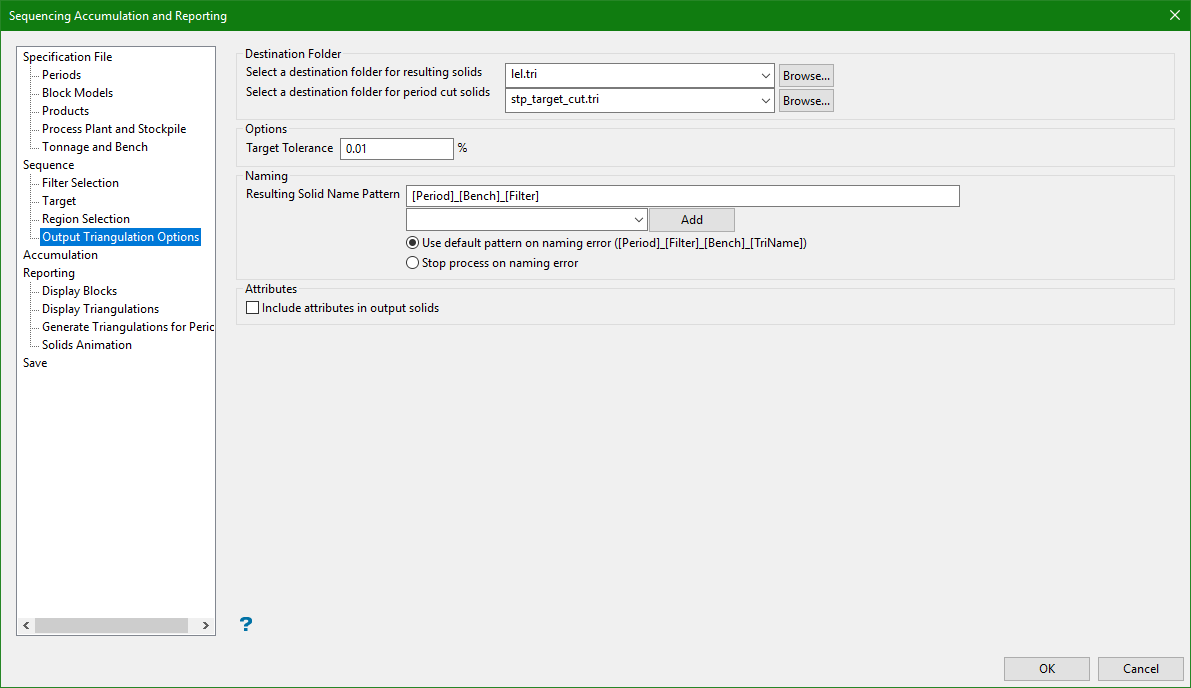Sequencing Accumulation and Reporting
Output Triangulation Options
Use the Output Triangulation Options to define where triangulations are saved that are to be used with the Sequencing Accumulation and Reporting option.
Prerequisites
Before working in this panel, it is recommended you first:
- Load the desired Specification file
- Use the Target option to define process targets

Destination Folder
Select a destination folder for resulting solids
Select the folder in which to save the triangulations from the drop-down list, or browse for it by clicking the Browse button.
Options
Target Tolerance
The target tolerance is a value to add a flexibility in the triangulation cut. If the triangulation value (usually tonnage) is within range (plus or minus the tolerance), then the triangulation will meet the target. If you set small a value you will get more accurate targets, but it will take more time to get them. In the other hand, if you need speed in your calculations you can set a greater tolerance.
Naming
Resulting Solid Name Pattern
Use the drop-down list to select a parameter, then click the Add button to add it to the Resulting Solid Name Pattern.
Valid variables for the pattern are: Period, Bench, Filter, Solid Name and the field names defined in the first column (Field) of the Setting Fields grid in the Filter Selection tab.
The variables in the pattern should be surrounded by square brackets.
Any other text will be considered as a constant text in the name.
The default pattern is the current hardcoded pattern [Period]_[Filter]_[Bench]_[TriName]. You can choose to use the default pattern or stop the process on a naming error.
An empty space in the beginning of the pattern will be omitted in the naming generation.
Reserved characters that cannot be used include: < (less than), > (greater than), : (colon), " (double quote), / (forward slash), \ (backslash),| (vertical bar or pipe), ? (question mark), * (asterisk).
Similarly, Windows reserved words are not allowed for naming a solid. These include: CON, PRN, AUX, NUL, COM1, COM2, COM3, COM4, COM5, COM6, COM7, COM8, COM9, LPT1, LPT2, LPT3, LPT4, LPT5, LPT6, LPT7, LPT8, and LPT9.
If you do not select a pattern, STP will use the default pattern.
Duplicated names are not allowed. You will be warned in the console about such an error during the process. Select which option you want to use in the event of such an error, Use default pattern on naming error or Stop process on naming error.
Attributes
Include attributes in output solids
Select this to enable adding attributes to the output solids created. The attributes will consist of:
-
Period
-
Bench
-
[FilterName] (one for each setting)
-
[Product]_[report variable] (one for each product-variable combination)
Note: The variables to be used will be the ones set in the report definition.
Related topics
-
Sequence

